Understanding DoD
Tap the Innovation Ecosystem
The DoD has a vast collection of opportunities to spur innovation among entrepreneurs. There is not however, a single platform bringing all of this information together. This page offers content to navigate the DoD innovation ecosystem environment and locate opportunities suited to the technology and goals of a company.
This list represents the innovation organizations currently known to the authors. Omissions are unintentional, and we will update when new organizations are brought to our attention.
The innovation organizations currently known to the authors are described below. Omissions are unintentional, and we will update when new organizations are brought to our attention.
Air Force Research Lab | AFWERX | Army Applications Lab | Army Research Laboratory | Army SBIR/STTR | Catalyst Accelerator | Challenge.gov
Cyber Fusion Innovation Center | CyberWorx | Defense Advanced Research Projects Agency | Defense Innovation Marketplace | Defense Innovation Unit | DoD Labs DEFENSEWERX | DAF MIT AI Accelerator | Doolittle Institute | ERDCWERX | FLEETWERX | Hyperspace Challenge | IQT | National Security Innovation Capital National Security Innovation Network | Nautilus | Naval Research Laboratory | NavalX | Navy SBIR/STTR | SOFWERX | SPACEWERX
Space Systems Command Front Door | STRIKEWERX | Technology Advancement Center | Techstars Space Accelerator | XTechSearch
The following characterizations are an attempt to classify the offerings of the organizations profiled on this page:
 Accelerator. Accelerators offer competitive and structured programs focused on scaling the growth of an existing company. Accelerators typically provide some amount of seed money and a network of mentors. Programs are typically a few months in duration culminating in an opportunity to pitch to investors at the conclusion of the program.
Accelerator. Accelerators offer competitive and structured programs focused on scaling the growth of an existing company. Accelerators typically provide some amount of seed money and a network of mentors. Programs are typically a few months in duration culminating in an opportunity to pitch to investors at the conclusion of the program.
 Challenge. A challenge can be a single or recurring contest or competition aimed at solving problems where emerging technologies have the potential to provide non-traditional solutions, or to expand the pool of participants to address critical issues. Challenges may offer cash prizes or may be part of a broader Challenge-Based Acquisition (ChBA) strategy that may result in a government contract.
Challenge. A challenge can be a single or recurring contest or competition aimed at solving problems where emerging technologies have the potential to provide non-traditional solutions, or to expand the pool of participants to address critical issues. Challenges may offer cash prizes or may be part of a broader Challenge-Based Acquisition (ChBA) strategy that may result in a government contract.
 Connector. The objective of connector organizations is to build networks and create relationships between government organizations, industry, private equity firms, and academia to facilitate partnerships to solve challenging problems by generating new solutions.
Connector. The objective of connector organizations is to build networks and create relationships between government organizations, industry, private equity firms, and academia to facilitate partnerships to solve challenging problems by generating new solutions.
 Funding Opportunity. Funding opportunities are offered by organizations that seek to invest in and enhance the chances of success of entities (often start-ups or small businesses) pursuing advancements in technology. These are not government contracts or agreements.
Funding Opportunity. Funding opportunities are offered by organizations that seek to invest in and enhance the chances of success of entities (often start-ups or small businesses) pursuing advancements in technology. These are not government contracts or agreements.
 Government Contracting Authority. An organization with government contracting authority can execute contract awards or agreements for government projects. These organizations have warranted Contracting Officers who are authorized to execute awards and agreements on behalf of the government.
Government Contracting Authority. An organization with government contracting authority can execute contract awards or agreements for government projects. These organizations have warranted Contracting Officers who are authorized to execute awards and agreements on behalf of the government.
 Incubator. Incubators focus on start-up and entrepreneurial entities with innovative ideas. They may provide seed funding and a collaborative physical environment to grow ideas, brand identification, and business plans. Not-for-profit and government or university operated incubators seek to enhance the economy and/or advance the state of the art of the US industrial base for government stakeholders.
Incubator. Incubators focus on start-up and entrepreneurial entities with innovative ideas. They may provide seed funding and a collaborative physical environment to grow ideas, brand identification, and business plans. Not-for-profit and government or university operated incubators seek to enhance the economy and/or advance the state of the art of the US industrial base for government stakeholders.
MITRE’s Bridging Innovation Team offers a Visualization to assist in identifying the innovation organizations that may be well-suited for the Technology Readiness Level (TRL) of solution offerings.
Technology Readiness Levels: Section 2.5 of the DoD Technology Readiness Assessment (TRA) Guidance (April 2011) provides definitions and descriptions of TRLs. Appendix IV of the Government Accountability Office (GAO) Technology Readiness Assessment Guide (GAO-20-48G, January 2020) also provides TRL definitions and descriptions for the DoD as well as other organizations.
Office of the Secretary of Defense (OSD) Innovation Organizations
Defense Innovation Unit (DIU) accelerates adoption of commercial technology throughout the military and growing the national security innovation base. DIU partners with organizations across the Department of Defense to rapidly prototype and field dual-use capabilities that solve operational challenges at speed and scale.
DIU aims to move from problem identification to prototype awards in 60–90 days. Prototype projects typically run from 12–24 months and are awarded through a competitive Commercial Solutions Opening (CSO) process. DIU awards Prototype Other Transaction (OT) agreements, enabling non-competitive follow-on production OT agreement or FAR-based contract following a successful prototype.
After a successful prototype, the company involved and ANY DoD (and US government) organization can enter into a follow-on production contract or agreement. DIU maintains a Solutions Catalog of successfully prototyped commercial technology solutions available for immediate award.
Technology Focus Areas:
- Artificial Intelligence
- Autonomy
- Cyber and Telecom
- Emerging Technologies
- Energy
- Human Systems
- Space
How Gov organizations can leverage DIU: Contact DIU about a mission-critical challenge your organization is facing; DUI will explore next steps if you can offer a dedicated DIU liaison and funding to prototype solutions.
How industry partners can engage with DIU: View and respond to open solicitations.
National Security Innovation Capital (NSIC) is a DoD initiative that enables dual-use hardware startups to advance key milestones in their product development by addressing the shortfall of private investment from trusted sources. NSIC reports to Defense Innovation Unit leadership and operates distinctly from its sister organization, National Security Innovation Network, and core DIU.
NSIC awards Prototype Other Transaction (OT) agreements to accelerate productization efforts. NSIC seeks to engage domestic startups that are developing dual-use hardware products with both commercial and defense applications. NSIC is focused on engaging with domestic startups developing dual-use hardware technologies in the early stages of development or pre-production (TRL 3 or higher).
Technology Focus Areas:
NSIC is focused on next-generation hardware technologies for application to connected mobile and edge systems that support distributed operations in land, sea, air, and space domains.
- Autonomy & Robotics
- Computing & Communications
- Energy
- Sensors
- Space
How Gov organizations can leverage NSIC: Upon successful completion of a prototype project under the Prototype OT agreement, the Government and company may negotiate a follow-on production contract or agreement without further competition. Any concept/technology/solution successfully proven through a Prototype OT can be transitioned to production.
How industry partners can engage with NSIC: Submit a pitch using the Commercial Acceleration Opportunity (CAO) process.
National Security Innovation Network (NSIN) is a problem-solving network that adapts to the emerging needs of those who serve in the defense of national security. NSIN offers programs and services that connect innovators across communities that might not traditionally cross paths. NSIN brings together defense, academic, and entrepreneurial innovators to solve national security problems in new ways.
Talent Portfolio: Bridges the gap between students, academics, and entrepreneurs to engage with the Department of Defense.
Venture Portfolio: Develops and executes programs and services intended to facilitate access to emerging technology as it engages the talents of fast-moving innovators and non-traditional problem-solvers.
Transition Cell: Team of experts advising both commercial companies and government mission partners on strategies to bring dual-use technologies into the Department of Defense (DoD).
The Foundry program identifies, researches, and vets cutting-edge DoD technologies developed in government laboratories, Federally Funded Research and Development Centers (FFRDCs), and University Affiliated Research Centers (UARCs) and matches with teams of entrepreneurs during intensive, five-month cohorts. Foundry provides a path to commercialization for DoD lab tech, and a unique opportunity for entrepreneurs to build a company around cutting edge technology. At the end of the cohort, teams will compete for $50,000 in total cash prizes.
How Gov organizations can leverage NSIN: Submit a Problem Intake Form to start a conversation about leveraging NSIN programs to address technical challenges through emerging technology innovations in collaboration with defense, academia, and industry innovators.
How industry partners can engage with NSIN: Explore Venture Portfolio programs and opportunities, connect with NSIN experts through the Transition Cell, participate in NSIN Events and opportunity challenges. Apply to participate in a Foundry cohort.
DEFENSEWERX connects a national network of individuals, businesses, academia, and government organizations to enable creative and integrated solutions for DoD customers. DEFENSEWERX leverages Partnership Intermediary Agreements (PIAs) to facilitate technology transfer and transitions from applied research developed at military an private sector labs to industry.
DEFENSEWERX is an overarching entity for a family of Innovation Hubs – each focused on technology and innovation leveraging local businesses and innovators.
DEFENSEWERX Innovation Hubs
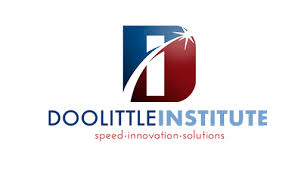
The Doolittle Institute (DI) is an Air Force Research Lab (AFRL) Innovation Institute supporting the AFRL Munitions Directorate (RW) to commercialize AFRL technologies in the private sector, enable rapid technology delivery to the warfighter, and identify and foster new research & development (R&D) partnerships.
The Doolittle Institute facilitates a variety of opportunities including Broad Agency Announcements, Patents & Licensing Agreements, and Technology Showcases. works with AFRL contacts within the Small Business Innovation Research (SBIR) and Small Business Technology Transfer (STTR) programs.
- Software-Enabled Weapons
- September 2026 Counter-Maritime Integrated Demo
- Increase Probability of Kill/Probability of Weapon Engagement
- Evaluate S&T Support to Munitions Manufacturability, Capacity/Surge
- Expand Autonomy R&D an Apply to Current Fielded or Near-Term Weapons
- Foundational S&T of Weapon Components
How Gov organizations can leverage the Doolittle Institute: Collaborate with AFRL/RW to leverage Broad Agency Announcements within the ARFL/RW Mission Priorities.
How industry partners can engage with the Doolittle Institute: Submit proposals under Broad Agency Announcements, license available AFRL patents, participate in collaborative Events, Activities, and Studies.

SOFWERX is an innovation platform that helps solve challenging Warfighter problems at scale through collaboration, ideation, events, and rapid prototyping. The SOFWERX ecosystem is comprised of industry, National Labs, academia, and government stakeholders.
The Foundry (located within the SOFWERX facility) offers engineering, additive, and traditional manufacturing for rapid prototyping and proof of concept.
How USSOCOM can leverage SOFWERX: Request a SOFWERX Event to solve warfighter problems, typically at no cost to the requester. Submit a Technology Focus Area request to assist in market research via Tech Tuesday virtual pitch events. Submit a Foundry Request to determine if SOFWERX manufacturing engineering capabilities can support Gov needs.
How industry partners can engage with SOFWERX: Participate in SOFWERX Events. Submit technologies for Tech Tuesday pitch forums.
ERDCWERX is an innovation hub providing streamlined path to collaboration and contracting with the U.S. Army Engineer Research and Development Center (ERDC). ERDCWERX takes innovation to the marketplace and warfighter through technology transition and technology transfer.
Technology Focus Areas:
- Civil and military engineering
- Geospatial sciences
- Water resources
- Environmental sciences for the Army, Department of Defense, civilian agencies, and our Nation’s public good
How Gov organizations can leverage ERDCWERX: Submit problems/challenges for Capability Assessments. Nominate projects/problems for Tech Challenges that may be structured as phased competitions leading to contract awards.
How industry partners can engage with ERDCWERX: Submit proposals to the ERDC Broad Agency Announcement, Prototype Opportunities, Commercial Solutions Openings. Participate in Events and Tech Challenges that may lead to contract awards. Request Licensing for available ERDC technologies.
Cyber Fusion Innovation Center (CFIC) is an innovation and collaboration space to aid the U.S. Army Cyber Command (ARCYBER) in defending the Department of Defense Information Network, delivering cyberspace effects, and rapidly developing and deploying cyberspace capabilities.
Technology Focus Areas:
- Technologies for securing and gaining visibility in operational technology space
- Cloud security and forensics technologies
- Secure information exchange and zero trust technologies
- Understanding software defects and associated vulnerability impact to the enterprise
- Network security, monitoring, and visualization technologies
- Technologies that enable seizing opportunities in radio frequency (RF) spectrum (EW/Cyber operations and AI enablement)
- Conferring experience: which technologies enable transfer of mission relevant experience to a workforce that possesses foundational education
- Software supply chain visibility and integrity technologies
- Technology that enables analytics for defense, offense, and HR (including graph analytics)
- AI/ML technologies to accelerate missions
- Collaboration Events: Collaborative design thinking events attended by warfighters, industry, academia, and National Labs. Outcomes shape future efforts, projects, and events.
- Assessment Events: One-on-one solution sessions with vendors providing solutions to ARCYBER problems that may lead to Other Transaction awards.
- Rapid Prototyping Events: Two-month events to rapidly prototype solutions to complex problem areas using low-cost, innovative technologies or techniques that may lead to Other Transaction awards.
How Gov organizations can leverage CFIC: Attend virtual Connector Series events and Conferences. Leverage Assessment and Rapid Prototyping Events for competitive Prototype Other Transaction Awards.
How industry partners can engage with CFIC: Join the CFIC ecosystem. Participate in virtual Connector Series events and Conferences. Submit Industry Request and Foreign Interest Forms to coordinate engagements with ARCYBER. Participate in Assessment and Rapid Prototyping Events to compete for Prototype Other Transaction Awards.
Nautilus uses research and development agreements, contracts, competitions, public-private partnerships, and other tools to address Navy and Marine Corps innovation challenges while helping grow the circle of entrepreneurs and investors interested in working the strategic and technical challenges associated with maintaining U.S. national security.
Events:
- Collaboration Events: Collaborative design thinking events attended by warfighters, industry, academia, and National Labs. Outcomes shape future efforts, projects, and events.
- Assessment Events: One-on-one solution sessions with vendors providing solutions to Navy/Marine Corp problems that may lead to cash prizes or contract awards.
How Gov organizations can leverage Nautilus: Facilitate a Collaboration or Assessment Event that may result in contract awards.
How industry partners can engage with Nautilus: Join the Nautilus ecosystem. Participate in Events that may lead to prizes or contract awards.
FLEETWERX is a non-profit organization working in close collaboration with the Naval Postgraduate School (NPS) and the Naval Fleet and Force. FLEETWERX mission is to streamline the discovery, engagement, and acceleration of inventive solutions that fortify naval operations.
FLEETWERX offers pathways for tech companies to integrate and test technologies with naval operations, accelerator programs designed to fast-track development of defense solutions, and provides connections that may lead to contract awards.
Technical Focus Areas:
- Artificial Intelligence
- 5G Networks
- Quantum S&T
- Autonomous Systems
- Hypersonics
- Cyberspace
- Space-based Capability
- Additive Manufacturing
How Gov organizations can leverage FLEETWERX: Request support to facilitate a FLEETWERX Event or Project that may lead to Research and Development Agreements (RDAs). Assistance to find and accelerate pathways to adopt innovative solutions.
How industry partners can engage with FLEETWERX: Join the FLEETWERX ecosystem. Participate in Opportunities and Events that may lead to Research and Development Agreements (RDAs).
Defense Advanced Research Projects Agency (DARPA) works within an innovation ecosystem that includes academia, industry (traditional, non-traditional, small business, and start-ups) and government partners to create new strategic opportunities and novel tactical options with military focus. DARPA awards contracts, grants, cooperative agreements, and Other Transactions in pursuit of DARPA’s research and development mission.
Small Business Innovation Research (SBIR) and Small Business Technology Transfer (STTR) programs that provide small, high-tech businesses and academic institutions the opportunity to propose radical, innovative, high-risk approaches to address existing and emerging national security threats.
Transition & Commercialization Support Program (TCSP) is designed to support transition and commercialization planning activities for DARPA-funded SBIR/STTR projects. The TCSP goal is to maximize the potential for SBIR/STTR companies to move their technology beyond Phase II, and into other research and development programs for further maturity, or into solutions or products for DoD acquisition programs, other Federal programs, and/or the commercial market.
Bridging Classified Innovation to Defense and Government Systems (BRIDGES) initiative is a pilot effort to connect innovation from small companies that traditionally do not work with the U.S. Government to classified DoD research and development (R&D) efforts. Goal is to connect innovators directly to the challenging problems that exist in the classified realm and to help develop solutions to those problems. BRIDGES aims to provide companies that demonstrate they can provide innovation and value to the DoD the means to obtain a facility clearance, and interact directly with DoD customers at classified levels.
Technology Offices:
- Biological Technologies Office (BTO)
- Defense Sciences Office (DSO)
- Information Innovation Office (I2O)
- Microsystems Technology Office (MTO)
- Strategic Technology Office (STO)
- Tactical Technology Office (TTO)
How Gov orgs can leverage DARPA: Successful SBIR/STTR Phase I and Phase II awardees are eligible for non-competitive Phase III awards by ANY Gov program. Engage with DARPA Operational Liaisons to transition DARPA technologies to the Services.
How industry partners can engage with DARPA: Submit proposals in response to DARPA SBIR/STTR Opportunities. Submit proposals in response to DARPA Opportunities. Participate in Events that bring together partners from across the science & technology ecosystem. Join the DARPAConnect community to access events, training, programs, and resources for engaging with DARPA.
Defense Innovation Marketplace is a resource enabling communication about DoD investment priorities to help industry better plan Independent Research & Development (IR&D) investment projects.
Communities of Interest (CoI) encourage multi-agency coordination and collaboration in cross-cutting technology focus areas with broad multiple Component investment and provide a forum for coordinating Science & Technology strategies across the Department, sharing new ideas, technical directions, and technology opportunities.
Technology Interchange Meetings (TIMs) allow DoD and industry/academia to cooperate on Research and Engineering technology challenges.
Technology areas:
- Advanced Electronics
- Air Platforms
- Autonomy
- Biomedical
- Biotechnology
- C4I
- Counter-IED
- Counter-WMD
- Cyber
- Directed Energy
- Electromagnetic Warfare
- Energy and Power
- Engineered Resilient Systems
- Ground and Sea Platforms
- Human Systems
- Kinetic Weapons
- Materials and Manufacturing Processes
- Sensors and Processing
- Space
How Gov organizations can leverage the Defense Innovation Marketplace: Search Industry Independent Research & Development (IR&D) innovative projects via the Government Portal. Participate in Technology Interchange Meetings (TIMs).
How industry partners can engage: Submit Independent Research & Development (IR&D) projects via the Industry Portal. Participate in Technology Interchange Meetings (TIMs).
DoD Laboratories
DoD Science and Technology Reinvention Laboratories (STRLs) are designated by either Congress or by the Under Secretary of Defense for Research and Engineering (USD R&E) and have unique funding flexibilities, authorities, and contractual vehicles available to them. The Laboratories engage in activities ranging from basic research through defense system acquisition support to direct operational support of deployed warfighters. Laboratories execute a substantial fraction of the Department’s S&T accounts, particularly in budget activities 6.2 and 6.3.
In addition to contracts, grants, and agreements, Labs are authorized to execute Cooperative Research and Development Agreements (CRADAs) to facilitate tech transfer between government and industry. This enables industry to further develop technology that originated in a DoD lab.
Examples of DoD Labs
The Air Force Research Laboratory (AFRL) leads the discovery, development and delivery of warfighting technologies for air, space, and cyberspace forces.
Air Force and Space Force Science and Technology Tech Connect is a service to connect potential partners with DAF science and technology experts and opportunities. It provides access to current, open opportunities, meet-up events, other DAF S&T enterprise connectors, and a way for anyone to share an idea. The Tech Connect team, comprised of AFRL personnel, connects quality, relevant ideas, and technologies with DAF subject matter experts. The team reviews ideas, provides feedback on innovative ideas, and establishes a dialogue with potentially interested Air Force and Space Force programs.
- Air Force Vanguards
- Space, Aerospace Systems
- Munitions
- Information
- Materials & Manufacturing
- Basic Research
- Directed Energy
- Human Performance
- Sensors
- Artificial Intelligence
- Quantum
- Hypersonics
- Digital Capabilities
- Integrated Capabilities
- Cross Domain
How to Gov organizations can leverage AFRL: Propose an idea to enhance operations through Air Force Challenge. Participate in the AFRL Commander’s Challenge to address complex problems, participants gain hands-on experience, leadership skills, and insights into AFRL processes. Attend Events (conferences, industry engagements, symposiums).
How industry partners can engage with AFRL: Submit proposals in response to Opportunities. Share in Idea with the AFRL Tech Connect Team. Attend S&T Events.
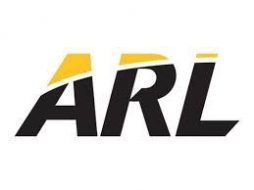
The Army Research Laboratory (ARL) executes intramural and extramural research organized that provide the Army with foundational expertise and specialized capabilities grounded in scientific excellence and driven by unique Army challenges.
- Biological and Biotechnology Sciences
- Humans in Complex Systems
- Photonics, Electronics, and Quantum Sciences
- Electromagnetic Spectrum Sciences
- Mechanical Sciences
- Sciences of Extreme Materials
- Energy Sciences
- Military Information Sciences
- Terminal Effects
- Network, Cyber, and Computational Sciences
- Weapons Sciences
How Gov organizations can leverage ARL: Collaborate with ARL to explore Funded Research opportunities in support of operational capability development.
How industry partners can engage with ARL: Submit proposals in response to ARL's Broad Agency Announcement. Participate in other Funded Research opportunities. Explore Technology Transfer opportunities.
The Naval Research Laboratory (NRL) is a scientific and engineering command dedicated to research that drives innovative advances for the U.S. Navy and the U.S. Marine Corps. NRL is the principal in-house component in the Office of Naval Research (ONR) effort to meet its science and technology responsibilities.
The Institute for Nanoscience conducts highly innovative, interdisciplinary research at the intersections of the fields of materials, electronics and biology in the nanometer size domain.
The Laboratory for Autonomous Systems Research provides specialized facilities to support highly innovative, multidisciplinary research in autonomous systems, including intelligent autonomy, human-autonomous system interaction and collaboration, sensor systems, power and energy systems, networking and communications, and platforms.
- Autonomous & Unmanned Systems
- Chemical & Biological Sciences
- Computational Physics
- Electronics
- Environments [Sea/Air/Space]
- Information and Social Sciences
- Materials
- Nanotechnology
- Optical Sciences
- Power & Energy
- Quantum Research
- Space Sciences
How Gov organizations can leverage NRL: Collaborate with NRL to explore research opportunities in support of operational capability development under the individual Research Areas.
How industry partners can engage with NRL: Review NRLs Long Range Acquisition Forecast. Submit proposals in response to NRL’s Broad Agency Announcements. Explore Technology Transfer opportunities.
Air Force and Space Force Innovation Organizations


AFWERX is the innovation arm of the Department of the Air Force and powered by the Air Force Research Laboratory (AFRL). The four core arms of AFWERX – AFVentures, Spark, Prime and SpaceWERX – serve to expand the defense industrial base for advanced technologies, empower Airmen and Guardian talent, and drive faster technology transition to operational capability.
AFVentures funds emerging technologies to deliver Air Force and Space Force capabilities and broaden access to disruptive innovation. AFVentures is responsible for the DAF SBIR/STTR program executed via the following mechanisms: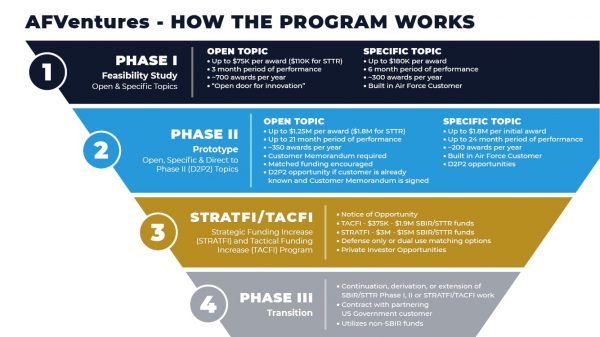
- Open Topic: a technology-agnostic solicitation which encourages commercial industry to submit dual-use technology solutions without necessarily having a known end-user.
- Specific Topic: clearly-defined, niche technology requirements and a known Air Force customer built into the topic solicitation.
- STRATFI/TACFI: Strategic and Tactical Funding Increase Programs bridge the capability gap between current SBIR/STTR Phase II efforts to achieve better technology transitions and de-risk development through syndication with multiple transition-focused partners and leveraging outside investment.
Additional Information: SBIR/STTR Award Details (2016+)
Spark connects Airman and Guardians to commercial innovators using virtual collaboration, immersive training, and networking opportunities to inspire ideas and cultivate a more creative force. Spark Programs support, develop, and empower DAF innovators.
Prime accelerates development of key dual-use technology sectors that advance U.S. national security and competitiveness, fielding rapid and affordable capability within a 2-4 year timeframe. Prime programs collaborate across academia, industry, investors, interagency, international, acquisition, laboratory, and warfighter communities. Current Prime programs include:
AFWERX Challenge empowers the U.S. Air Force and Space Force to discover and develop innovative solutions to complex problems at an accelerated pace, playing an important role in deterring conflict and ensuring our nation’s security. Challenge themes focus on expanding the defense industrial base for emerging and advanced technologies, nurturing the talent of Airmen and Guardians, and expediting the transition of cutting edge technologies into operational effectiveness.


SPACEWERX is the innovation arm of the U.S. Space Force and a unique division within AFWERX. SpaceWERX inspires and empowers collaboration with innovators to accelerate capabilities and shape our future in space. SpaceWERX partners with Space Systems Command’s Commercial Space Office (COMSO) as a collaborative program.
Space Ventures works with industry to identify, mature, and accelerate capabilities. In addition, this investment arm creates pathways for innovators and private capital investors to help advance Space Force technologies. In this role, the U.S. Space Force becomes an early-stage investor by offering non-dilutive capital to accelerate commercialization and partnerships that address military needs.
How Gov organizations can leverage AFWERX and SPACEWERX: Leverage the Innovation Handbook. Develop a Challenge that may result in contract awards. Get help via the AFWERX Portal. Connect with Spark Programs. Participate in the Refinery Innovation Accelerator.
How industry partners can engage with AFWERX and SPACEWERX: Submit proposals to SBIR/STTR Open Topics and Specific Topics. Apply for STRATFI/TACFI programs. Respond to current Challenges. Register for Challenge Events. Join the AFWERX/SPACEWERX ecosystem.
The Catalyst Accelerator is a semi-residential, three-month program for small businesses that provides business development training, connections with users and DoD liaisons, and fosters mentorship with industry and DoD subject matter experts. Accelerators are currently offered in Colorado Springs, CO and Ogden, UT.
The program culminates in a Demo Day where cohort companies pitch their technology to Government, Industry, Academia, and Investor stakeholders during the last week of the Accelerator.
How Gov organizations can leverage The Catalyst Accelerator: Participate in Accelerator Events to engage with innovators. Engage with the Colorado Springs Accelerator. Engage with the Ogden Accelerator.
How industry partners can engage with The Catalyst Accelerator: Join Accelerator Events. Apply for Colorado Springs Accelerator. Apply for the Ogden Accelerators. Contact The Colorado Springs Accelerator. Contact the Ogden Accelerator.
CyberWorx is an innovation lab focused on rapidly prototyping solutions for Department of the Air Force and Department of Defense problems by identifying and focusing on user (warfighter) needs.
Technology Focus Areas:
- Hardware
- Software
- Apply
- Policy
- Organizational Change
- Mental Health
How Gov organizations can leverage CyberWorx: Contact the CyberWorx team. Leverage the Innovation Toolkit.
How industry partners can engage with CyberWorx: Apply to be an industry partner. Contact the CyberWorx team. Review new and exiting Projects. Submit a proposal under the CyberWorx CSO and BAA.
DAF MIT AI Accelerator combines the expertise and resources of MIT and the Air Force and Space Force to conduct fundamental research enabling rapid prototyping, scaling, and application of AI algorithms and systems.
The AI Accelerator is designed to make fundamental advances in artificial intelligence that improve Air Force operations while also addressing broader societal needs. AI Accelerator research teams consist of interdisciplinary teams, including Airmen, that collaborate across different fields of AI to create new algorithms and tools.
How Gov organizations can leverage the AI Accelerator: Review Research from past projects and challenges. Contact the AI Accelerator if you have challenges that may be solved by AI.
How industry partners can engage with the AI Accelerator: Participate in Challenges.
Hyperspace Challenge is a business accelerator fueled by the U.S. Space Force and Air Force Research Lab, in partnership with CNM Ingenuity, to support the Space Vehicles directorate and our U.S. government personnel everywhere. Hyperspace Challenge forges valuable relationships between the government, industry, and university communities to accelerate innovation for the space domain.
How Gov organizations can leverage Hyperspace Challenge: Participate in Webinars.
How industry partners can engage with Hyperspace Challenge: Participate in Webinars. Subscribe to Hyperspace Challenge on YouTube. Participate in Challenge events.
Space Systems Command Front Door facilitates DoD and government agency collaboration with commercial companies that seek to grow or share tested and emerging technologies that may advance our nation's space-based capabilities and strengthen our national security. Front Door is administered by Space Systems Command (SSC), a field command of the United States Space Force (USSF). Front Door offers:
- A first step for early-stage startups, non-traditional partners, and other commercial vendors to engage with the US Space Force.
- A central point of connection and useful information exchange for industry and government stakeholders.
- Focus on discovering and aligning innovative technologies and capabilities to space systems programs and mission areas and priorities.
- Informs startups, non-traditional partners, and commercial vendors of Space Force technology and capability needs to help them better understand and potentially support the “art of the possible”.
- Helps facilitate engagement and connect commercial vendors and businesses to Space Force Command and DoD organizations.
- Assured Access to Space
- Battle Management Command, Control & Communications
- Military Satellite Communications
- Position, Navigation, and Timing
- Space Sensing
- Space Combat Power
- Space Domain Awareness
- Space Segment
- Operations
- Ground Segment
- Digital Services
How Gov organizations can leverage Front Door: Contact Front Door to connect with early-stage start-ups and commercial innovators with solutions that may have potential to close capability gaps. Attend Events to interact with innovators.
How industry partners can leverage Front Door: Share an Idea, Product, or Service to increase opportunities for discussions and collaborations with SSC and the space enterprise. Attend Front Door Events.
STRIKEWERX is an innovation arm of the Air Force Global Strike Command (AFGSC) Office of the Chief Scientist. STRIKEWERX provides industry, academia and the warfighter access to opportunities where all three entities can combine resources to solve the critical needs of Air Force Global Strike Command.
Technology Focus Areas:
- Machine learning/artificial intelligence (AI)
- Data analytics
- Decision tools
- Advanced learning technologies
- Affordable digital twin
- High-altitude Electromagnetic Pulse (HEMP) hardening
- Advances in power technologies
- Advanced materials and advanced manufacturing technologies for small batch production
- Advances in augmented reality (AR), virtual reality (VR) & mixed reality (MR)
- Affordable/mobile physical security
- Software automation
- Human Factors
- Counter-small Unmanned Aircraft Systems (C-sUAS)
How Gov organizations can leverage STRIKEWERX: Participate in STRIKETANK and STRIKEWERX Spark Events to pitch ideas and solutions. View Resources for opportunities to engage with STRIKEWERX.
How industry partners can engage with STRIKEWERX: Contact STRIKEWERX to engage with AFGSC. View Resources for opportunities to engage with STRIKEWERX.
Techstars Space Accelerator runs in partnership with the United States Space Force and NASA’s Jet Propulsion Laboratory focused on ext generation of space technology companies from adjacent industries (i.e., automotive, agriculture, energy, mining, finance, and manufacturing) that seek access to the aerospace industry as a primary go-to-market channel, and technologies that can be applied commercially into the space and aerospace sectors (i.e., autonomy, robotics, etc).
Technology Focus Areas:
- SmallSats
- Applied AI and ML
- Digital Design and Collaboration tools
- Geospatial Analytics
- Autonomous Systems
- Robotics
- Advanced Manufacturing
- Advanced Structures
- Systems-on-chip computing
- Avionics
- Drones/UAS
- Communications
- Earth Observation
- Edge Computing and Big Data Processing
- In-Orbit Servicing
- Navigation
- Perception
- Sensors
- Quantum technologies
- Cybersecurity
- Power Systems (energy generation, energy storage, energy management)
How Gov organizations can leverage Techstars Space Accelerator: Participate in Demo Day Events to see founders pitch their business to investors, mentors, and Gov organizations. Fall 2024 Accelerator.
How industry partners can engage with Techstars Space Accelerator: Connect with the Techstars Space Accelerator. Apply to participate in the Accelerator to access the world’s leaders in the aerospace industry to help advance in market positioning, customer acquisition, product development and overall growth.
Army Innovation Organizations
Army Applications Lab is part of Army Futures Command (AFC) and coordinates projects, resources, and communities against critical Army problems.
Technology Focus Areas:
- Power and Energy
- Human Performance
- Robotics and Tactical AI
- Contested Logistics
How Gov organizations can leverage AAL: Partner with AAL to align warfighter problems with AAL projects and find commercial technology that may solve an operational need.
How industry partners can engage with AAL: Join the AAL network to get notified of new opportunities. Submit proposals through the SPARTN SBIR Program. Submit a whitepaper through the AAL Broad Agency Announcement. Apply to Open Project Opportunities.
Army SBIR/STTR Program Army Small Business Innovation Research (SBIR) and Small Business Technology Transfer (STTR) programs align innovative small businesses with critical U.S. Army priorities to turnover game-changing solutions to our most critical customer—the Soldier.
- Assistant Secretary of the Army (Acquisition, Logistics, and Technology (ASA(ALT)) releases SBIR topics on a rolling basis on an always-open Broad Agency Announcement (BAA).
- Army Futures Command (AFC) SBIR/STTR Programs develop a set of research topics that represent the Army’s current and anticipated war-fighting technology needs and release topics during three specific solicitation periods throughout the fiscal year
Army SBIR CATALYST objective is to test and demonstrate proposed solutions at a PEO-sponsored demonstration and to increase the speed of technology transition into Army Programs of Record. Awards may include any combination of Phase II ($15 million), Direct to Phase II ($15 million), or Sequential Phase II ($15 million), or Phase II Enhancement ($14 million) awards. To be eligible to receive a Phase II Sequential or Phase II Enhancement CATALYST award, a small business must have been awarded a base Phase II SBIR|STTR award by any government organization executed no earlier than FY20. Requires Army transition partners to recommend SBIR projects for the program via an application process. Webinar on the Army SBIR CATALYST Program.
The Technical and Business Assistance (TABA) Program provides targeted support to small businesses, offering resources and assistance in a variety of areas, which may vary depending on the specific alignment with business needs.
Technology areas:
- Advanced Materials and Manufacturing
- Additive Manufacturing
- AI/ML
- Supply Chain Management, Logistics Coordination, Target Identifications, and Simulation
- Autonomy
- Unmanned Systems, Drones, Ground Vehicle Capabilities
- Chemical and Biological
- Detection, Defense
- Cyber
- Biometric Authentication, Secure Communication
- Electronic Warfare
- Jamming, Spoofing
How Gov organizations can leverage Army SBIR/STTR: Recommend SBIR projects for the SBIR CATALYST.
How industry partners can engage with Army SBIR/STTR: Submit proposals to SBIR/STTR Open Topics. Contact the SBIR/STTR team.
xTech hosts Army prize competitions, connecting businesses with Army and DoD experts to build solutions for current problems. In addition to cash prizes, businesses are given opportunities to receive follow-on contracts and direct exposure to Army experts and commercial stakeholders – supplying businesses with key networking, education and mentorship opportunities. xTech is led by the Assistant Secretary of the Army for Acquisition, Logistics, and Technology (ASA(ALT)) and handles all Army prize competitions to award and accelerate innovative technology solutions.
xTech runs various types of competitions under two prize authorities:
- 10 U.S.C. §4025: Provides a mechanism for both cash prize awards and the option to have follow-on contracts such as Small Business Innovation Research (SBIR) and Other Transaction Authorities.
- 15 USC §3719: Provides a mechanism for cash prize awards.
xTech Accelerator is designed to provide the finalist with guidance in understanding the Army ecosystem, making introductions to key stakeholders and helping to build lasting relationships.
How Gov organizations can leverage xTech: Partner with xTechSearch to conduct a Competition to fill mission gaps.
How industry partners can engage with xTech: Apply to participate in xTech Open Competitions.
Non-DoD Innovation Organizations
Challenge.gov provides a platform for the federal government and the public to join together to solve important problems by maturing and scaling the use of prize competitions in order to advance their missions. Managed by the General Services Administration (GSA).
Challenge.gov enables federal agencies to engage public solvers in challenges and prize competitions (together referred to as “prize competitions”) to identify innovative solutions to critical issues.
How Gov organizations can leverage Challenge.gov: Visit the Challenge and Prize Toolkit and Resources for considerations and best practices for designing and executing successful competitions. Contact Challenge.gov to learn how to get started.
How industry partners can engage with Challenge.gov: Participate in Challenges and Events. View Resources. Follow Challenge.gov on social media: Twitter, Facebook, LinkedIn, & YouTube.
IQT delivers best-in-class capabilities, strategic technology insights, and other services to our partners through our unique global investment platform.
IQT’s unique approach pairing high-tech problem solvers with government challenges has produced countless impactful solutions for the CIA; DIA; FBI; NGA; NRO; NSA; DHS (including CBP and other DHS components); U.S. Cyber Command; the Office of Strategic Capital (ONR); and the U.K. and Australian national intelligence communities. IQT recently welcomed the Office of Naval Research (ONR), U.S. Central Command, and U.S. Space Force as new government partners and look forward to supporting their missions too.
IQT has two primary tools for building a relationship with a promising company, both of which where IQT receives a small equity stake and status as a board observer:
- Work programs transactions typically involve an investment between $500,000 and $3 million and are structured as development and licensing agreements aimed at addressing the needs of the U.S. national security community.
- Equity-only investments typically range between $250,000 and $500,000 and serve as a critical window into new technologies and as an on-ramp toward future technology transfer opportunities leveraging IQT's unique and powerful model.
IQT's Government Platform Accelerator program provides content and coaching to startups to speed their entry into the public-sector market, including white papers, webinars, and training sessions.
How Gov organizations can leverage IQT: Partner with IQT to work with visionary founders and companies to create and shape new mission capabilities. Review IQT Portfolio investments.
How industry partners can engage with IQT: Connect with IQT to access a pathway to connect and collaborate with the government.
Technology Advancement Center (TAC) serves as an intermediary and helps connect the U.S. Government to the innovative products and solutions needed to advance the nation’s cybersecurity capabilities through collaboration with small business, academic researchers, and non-traditional members of the cybersecurity community.
TAC operates programs out of TAC facilities, including two Defense Mission Accelerators that serve as non-government-owned or operated independent facilities to provide cyber national mission forces and partners with continuous innovation in cyber capabilities:
- The Link is an open facility that welcomes the public to tour, collaborate, and prototype in support of USCYBERCOM and its mission partners. Daily, monthly, and quarterly collaboration events are announced through our website and via email for those that register to participate in TAC’s Partnership Network.
- DiscoveryX facilitates collaboration among industry, academia, and government organizations to develop solutions addressing critical national security challenges.
Technology areas:
- Vulnerabilities and Exploits
- Network Security, Monitoring, and Visualization
- Modeling and Predictive Analytics
- Persona and Identity
- Permeability and Agility Across Domains
- Infrastructure and Transport
How Gov organizations can leverage TAC: Participate in TAC Events to connect with the TAC cybersecurity community and explore innovative, cutting-edge technologies for cybersecurity challenges.
How industry partners can engge TAC: Join the TAC ecosystem to engage and collaborate on national cybersecurity solutions. Participate in TAC Events and Opportunities.





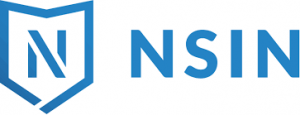

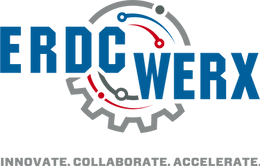
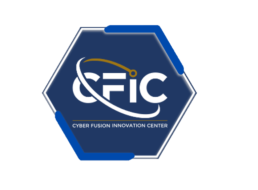

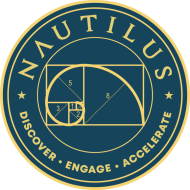
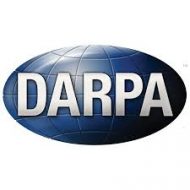

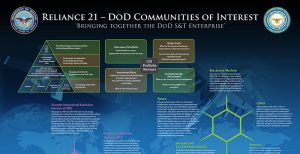
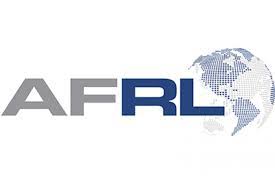
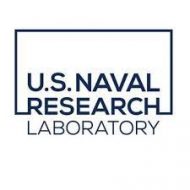
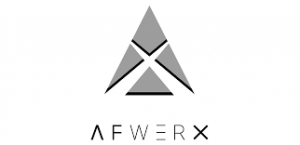



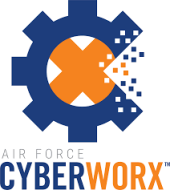


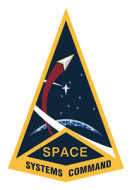
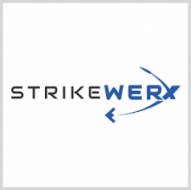


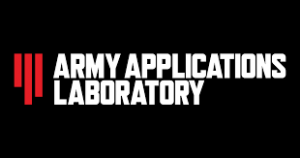
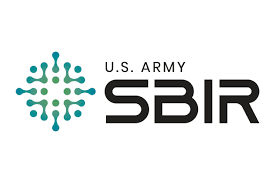


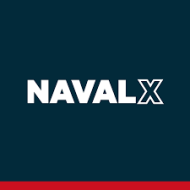
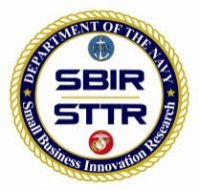
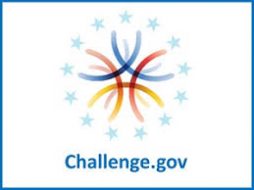

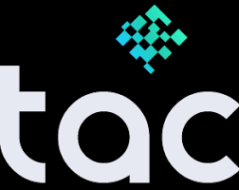
0 Comments